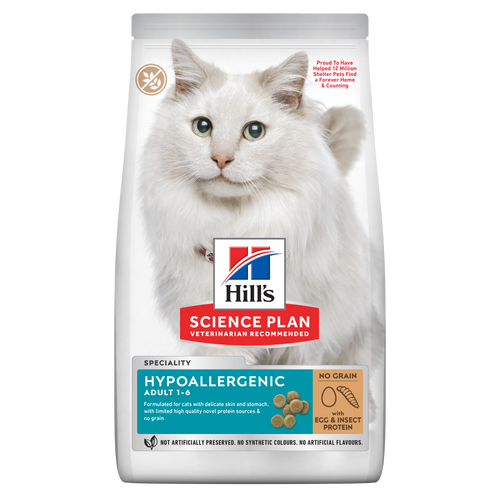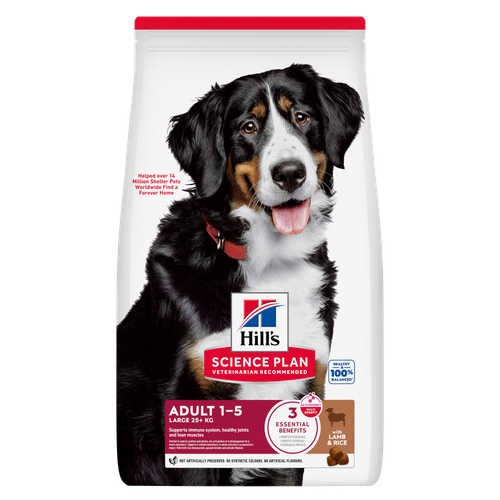
-
Find the right food for your petTake this quiz to see which food may be the best for your furry friend.Find the right food for your petTake this quiz to see which food may be the best for your furry friend.Featured products
 Perfect Digestion Small & Mini Adult Dog Food
Perfect Digestion Small & Mini Adult Dog FoodHill's Science Plan Perfect Digestion Small & Mini Breed Adult Dog Food with Chicken & Brown Rice supports ultimate digestive well-being & a healthy microbiome.
Shop Now Small & Mini Mature Adult 7+ Dog Food
Small & Mini Mature Adult 7+ Dog FoodHill's Science Plan Small & Mini Breed Mature Adult Dog Food with Chicken is a complete pet food, specially formulated with ActivBiome+ Multi-Benefit Technology.
Tailored nutrition to support graceful ageing in small dogs. Specially made with a synergistic blend of nutrients for energy & vigor.Shop Now Perfect Digestion Large Breed Puppy Food
Perfect Digestion Large Breed Puppy FoodPrecisely balanced nutrition with Hill's ActivBiome+ prebiotic blend actively contributes to supporting digestive health and overall well-being to help your pet feel their best
Shop NowFeatured products Hypoallergenic Dry Cat Food
Hypoallergenic Dry Cat FoodHILL'S SCIENCE PLAN Hypoallergenic Adult cat food with egg & insect protein is a complete pet food for adult cat 1–6 years old. It's formulated for cats with delicate skin and stomach, with limited high quality novel protein sources & no grain.
Shop Now Hairball & Perfect Coat Adult Cat Food
Hairball & Perfect Coat Adult Cat FoodHill's Science Plan HAIRBALL & PERFECT COAT Adult cat food with Chicken is specially formulated to effectively help avoid hairball formation in adult cats while promoting a beautiful coat. Thanks to its mix of essential Omega-6 fatty acids, this food benefits the cat's skin and fur keeping them healthy and shiny. Our Advanced Fibre Technology helps reduce hairballs by naturally promoting their passage through the gut. This food is formulated with high-quality protein for a perfectly balanced, great-tasting recipe.
Shop Now Kitten Food
Kitten FoodTender chicken chunks in gravy for kittens, with omega-3s for healthy eye & brain development and high-quality protein to support muscle growth. With balanced minerals to promote strong bones & teeth.
Shop Now -
Dog
- Dog Tips & Articles
-
Health Category
- Weight
- Food & Environmental Sensitivities
- Urinary
- Digestive
- Joint
- Kidney
-
Life Stage
- Puppy Nutrition
- Adult Nutrition
- Senior Nutrition
Cat- Cat Tips & Articles
-
Health Category
- Weight
- Skin & Food Sensitivities
- Urinary
- Digestive
- Kidney
-
Life Stage
- Kitten Nutrition
- Adult Nutrition
Featured articles Pet Food Storage Tips
Pet Food Storage TipsWhere you store your cat and dog food can make a big difference in the quality and freshness once it is opened. Here are some common questions and recommendations for optimal storage for all of Hill’s dry and canned cat and dog food.
Read More The Right Diet For Your Pet
The Right Diet For Your PetLearn what to look for in healthy pet food & nutrition, including ingredients, quality of the manufacturer, your pet's age, and any special needs they have
Read More Understanding Your Pet's Microbiome
Understanding Your Pet's MicrobiomeLearn what a pet's microbiome is, how it contributes to your pet's gut & overall health, and why nutrition is important in maintaining healthy microbiomes.
Read More -


Can dogs get splinters? Even though their paw pads are pretty tough, they can still be penetrated by thorns and splinters of wood, glass, metal or any other hard, sharp material. Dogs may be so focused on sniffing, playing or chasing a ball that they might not see sharp hazards that can end up as a splinter in a dog's paw.
Paws aren't the only body part that are at risk for splinters. Dogs don't tend to discriminate when they are chewing on something fun or delicious (they are missing that whole prefrontal cortex logic part of the brain), so they can sometimes end up with bone splinters stuck in their mouths.
Here's a look at how you can figure out if your furry friend has a splinter and what you can do to help them.
Signs Your Dog Has a Splinter
Now that you indeed know that dogs can get splinters, it's important to know the signs. If your dog suddenly starts limping, don't panic! It could be a simple splinter, thorn or insect sting. If you notice your dog is excessively licking or chewing at a paw or other body part, it could also be a splinter. If your dog is pawing at their mouth, drooling, refusing to eat, chewing only on one side or suddenly head shy, there could be a splinter in their mouth.



Tasty Tips
What to Do if You Notice a Splinter in a Dog's Paw
If you can see the end of the splinter poking through the skin, there is a good possibility that you can remove it yourself quickly and easily, provided your dog will let you. Remember — safety first! Even the nicest dog can bite if they're in pain. If you attempt this, make sure you don't push the splinter farther in. Don't be afraid to trim the hair around the splinter to make it more visible. Using tweezers (the ones from first-aid kits are the best for this kind of work), firmly grasp the end of the splinter. You want to pull it out slowly and smoothly to avoid breaking off any part of the splinter under the skin. Make sure to pull in the direction of the splinter and not up and out, as this has a tendency to break the splinter. After you remove the splinter, use a cotton ball or swab to apply some dog-safe antiseptic to the wound; talk to your veterinarian to get their recommendation for the safest antiseptics for your dog.
If the splinter is completely embedded under the skin or not visible to you, do not try to extract it. Doing so may cause stress and injury to you and your pet. You can try soaking your dog's paw in a bowl filled with a warm Epsom salt solution for five to ten minutes. Doing so may soften the area and bring the splinter close enough to the surface of the skin so that you can see it and grab it. You might also want to enlist the help of a friend or family member to help hold your dog to keep them relaxed and free you up to concentrate on getting the splinter out. Again — safety first!
When to See a Veterinarian
While a splinter is usually nothing to worry about, there are some situations where it's best to let your vet take care of a splinter. A vet needs to get involved if your dog:
- has a splinter in their mouth.
- has a splinter (anywhere) that doesn't come out in 24 hours.
- becomes agitated when you try to remove the splinter.
- is limping or licking the affected area.
- has an infection that appears to be forming.
Don't panic! Enlist the help of your friendly neighborhood vet who can extract the splinter, keep everybody safe and manage pain and stress.
Dogs can get splinters just like humans, but knowing how to spot the signs of a splinter and take care of it promptly can help keep your pup happy, healthy and splinter-free.


Dr. Sarah Wooten graduated from UC Davis School of Veterinary Medicine in 2002. A member of the American Society of Veterinary Journalists, Dr. Wooten divides her professional time between small animal practice in Greeley, Colorado, public speaking on associate issues, leadership, and client communication, and writing. She enjoys camping with her family, skiing, SCUBA, and participating in triathlons.
Related products

Hill's Science Plan Small & Mini Breed Mature Adult Dog Food with Chicken is a complete pet food, specially formulated with ActivBiome+ Multi-Benefit Technology.
Tailored nutrition to support graceful ageing in small dogs. Specially made with a synergistic blend of nutrients for energy & vigor.

Precisely balanced nutrition with Hill's ActivBiome+ prebiotic blend actively contributes to supporting digestive health and overall well-being to help your pet feel their best

Hill's Science Plan Large Breed Adult Dog Food with Lamb & Rice is a complete pet food, specially formulated with ActivBiome+ Multi-Benefit Technology.
This food is specifically designed to fuel the energy needs of large breed dogs during the prime of their life.

Hill's Science Plan Perfect Digestion Small & Mini Breed Adult Dog Food with Chicken & Brown Rice supports ultimate digestive well-being & a healthy microbiome.
Related articles

Discover how the field of dog science is giving us more and more insights into the inner workings of our furry best friends.

Dog obesity is a significant problem - learn more about helping your dog become trimmer and healthier through improved nutrition.

Discover the causes, signs, and treatments of kidney disease in dogs and find methods of supporting your dog's kidney health. Learn more at Hill's Pet South Africa.

Learn about snake bites on dogs, including clinical symptoms to look for, what to do if you think your dog was bitten, and treatment & prevention options.

Put your dog on a diet without them knowing
Our low calorie formula helps you control your dog's weight. It's packed with high-quality protein for building lean muscles, and made with purposeful ingredients for a flavorful, nutritious meal. Clinically proven antioxidants, Vitamin C+E, help promote a healthy immune system.
Put your dog on a diet without them knowing
Our low calorie formula helps you control your dog's weight. It's packed with high-quality protein for building lean muscles, and made with purposeful ingredients for a flavorful, nutritious meal. Clinically proven antioxidants, Vitamin C+E, help promote a healthy immune system.

